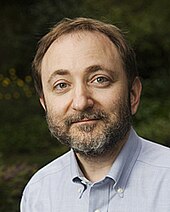Andrew Z. Fire
Andrew Zachary Fire (born April 27, 1959 in Palo Alto , Santa Clara County , California ) is an American biologist. In 2006, together with Craig C. Mello, he received the Nobel Prize in Physiology or Medicine for a method with which genes can be specifically silenced ( RNA interference ).
Life
Fire completed his mathematics degree at the University of California at Berkeley in three years . At the age of 19 he moved to the biology faculty at the Massachusetts Institute of Technology in Cambridge , where he worked under the later Nobel Prize winner Phillip Allen Sharp in the field of cell biology .
In 1983 he received his Ph.D. and then went to Cambridge in England to Sydney Brenner . With this he began his research on Caenorhabditis elegans . In 1986 he joined the Department of Embryology at the Carnegie Institution of Washington in Baltimore . In 1998, through experiments with the nematode Caenorhabditis elegans, together with Mello, he was able to prove that the injection of double-stranded RNA molecules can suppress the function of genes better than gene-specific single-stranded RNA. In 2003 he went to Stanford University School of Medicine , where he did research in the Department of Pathology and Genetics ; since 2004 he has been professor of pathology and genetics there.
Awards
- 1997: Maryland Distinguished Young Scientist Award
- 2002: Genetics Society of America Medal
- 2002: Meyenburg Prize
- 2003: Passano Award
- 2003: National Academy of Sciences Award in Molecular Biology , with Craig Mello
- 2003: Wiley Prize in Biomedical Sciences (together with Craig C. Mello, Thomas Tuschl and David Baulcombe )
- 2004: HP Heineken Prize for Biochemistry and Biophysics
- 2004: Elected member of the American Academy of Arts and Sciences and the National Academy of Sciences
- 2005: Massry Prize (together with Craig Mello)
- 2005: Gairdner Foundation International Award
- 2006: Paul Ehrlich and Ludwig Darmstaedter Prize , Young Talent Prize, together with Craig Mello
- 2006: Nobel Prize in Physiology or Medicine, with Craig Mello
Publications
- Andrew Fire, Siqun Xu, Mary K. Montgomery, Steven A. Kostas, Samuel E. Driver and Craig C. Mello : Potent and specific genetic interference by double-stranded RNA in Caenorhabditis elegans . In: Nature . Volume 391, 1998, pp. 806-811, PMID 9486653 PDF
- Nucleic acid structure and intracellular immunity: some recent ideas from the world of RNAi. In: Q Rev Biophys. 2006, pp. 1-7.
- A. Fire, R. Alcazar and F. Tan: Unusual DNA structures associated with germline genetic activity in Caenorhabditis elegans. Genetics 2006.
- D. Blanchard, H. Hutter, J. Fleenor and A. Fire: A differential cytolocalization assay for analysis of macromolecular assemblies in the eukaryotic cytoplasm. In: Mol Cell Proteomics. 2006.
- F. Moreno-Herrero, R. Seidel, SM Johnson, A. Fire and NH Dekker: Structural analysis of hyperperiodic DNA from Caenorhabditis elegans. in: Nucleic Acids Res. Volume 34, No. 10, 2006, pp. 3057-3066.
- ML Foehr, AS Lindy, RC Fairbank, NM Amin, M. Xu, J. Yanowitz, AZ Fire and J. Liu: An antagonistic role for the C. elegans Schnurri homolog SMA-9 in modulating TGFbeta signaling during mesodermal patterning. In: Development. Volume 133, No. 15, 2006, pp. 2887-2896.
Web links
- Information from the Nobel Foundation on the 2006 award ceremony for Andrew Z. Fire
- Andrew Fire's Stanford website
Footnotes
- ↑ Nature . Volume 391, 1998, 806
- ↑ HP-Heineken Prize 2004, accessed on November 27, 2019
- ↑ "RNA interference: chopping and cutting in the service of cell health" , on the website of the Goethe University Frankfurt am Main, accessed on November 27, 2019
- ^ The Nobel Prize in Physiology or Medicine 2006
| personal data | |
|---|---|
| SURNAME | Fire, Andrew Z. |
| ALTERNATIVE NAMES | Fire, Andrew Zachary (full name) |
| BRIEF DESCRIPTION | American biologist |
| DATE OF BIRTH | April 27, 1959 |
| PLACE OF BIRTH | Palo Alto , Santa Clara County , California , USA |
